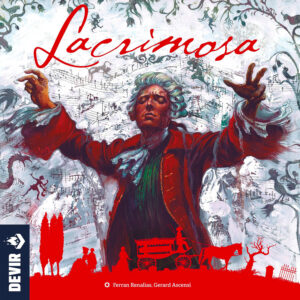I hope this review finds you in excellent spirits. Alas, I cannot share in such revelry. I’ve just learned that Wolfgang Amadeus Mozart, a beloved inspiration to us all, has passed on from this mortal coil. And while it’s come to my attention that this happened over two centuries ago, my heart still weighs heavy from the loss. Now I fear that this news may shatter your own spirits if you too are learning this information for the first time. Perhaps this will cause so much grief that you no longer read further? And yet…
Be strong! For there are many good tidings to come, though this will not be without a counterpoint here or there. It is my intention to share this new game without misinterpreting its impact on my gaming group. Published by Devir Games and designed by Gerard Ascensi and Ferran Renalias, Lacrimosa plays from one to four Mozart aficionados, or maybe just some competitive euro gamers.
I eagerly await your comments. Sincerely, B.
Gameplay Overview:
Over five rounds and set in different eras of Mozart’s life, you play as a patron to the composer, charged by his widow Constanze to tell stories of your travels together, as well as sponsor the completion of his final composition. Much of this activity happens on a central board that features a map for travel, a card market, as well as a scoresheet that represents the Requiem that must be completed.
Before play begins, players are given a large dual-layered player board, a deck of nine cards, as well as various markers that indicate income, resources, and composer bonuses. You begin by drawing four cards and must choose two to play. One slides into a recessed space at the top of your player board and becomes your action. The second slides into the bottom and indicates potential end of round income.
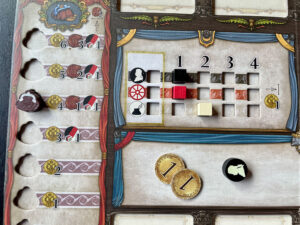
This card play is essential to understanding round structure and available actions. All players start with the same memory cards in their decks, but as these are shuffled each round, it creates a diverse array of timing. Each card has a single action in the beginning, but cards can be upgraded via an action (explained below) to potentially create even better future actions. The same can be said for resource income on the bottom of these new cards. Any time a card is upgraded it provides more lucrative options.
There are five main actions as well as free bonus actions associated with resource conversion. The five actions are as follows:
• Document Memories: Upgrade a memory card, paying the indicated cost, thus boosting future actions.
• Commission an Opus: Gain an opus card to add to your display, paying the indicated cost and gaining victory points.
• Perform or Sell Music: Choose an opus card in your play area to either perform for quick coin or sell to boost end of round income.
• Travel: Move a player-shared Mozart meeple on the main map to visit new locations, gain bonuses, and gain end game scoring tiles.
• Requiem: Fund one of two composer contemporaries who are finishing the Requiem. Players choose between the five movements and their available instruments.
After eight of the nine cards are utilized the round ends and players gain their income. Income boosts player’s Story Points for the next round (these are the currency for specific areas of the board), their coin, as well as provide one-time use story tokens to boost available resources. The main board is reset, the market row adjusted for the next era, and a new round begins. Upon ending the final round, players score their obtained Royal Court tiles, their contribution to the Requiem, and receive points for any leftover resources.
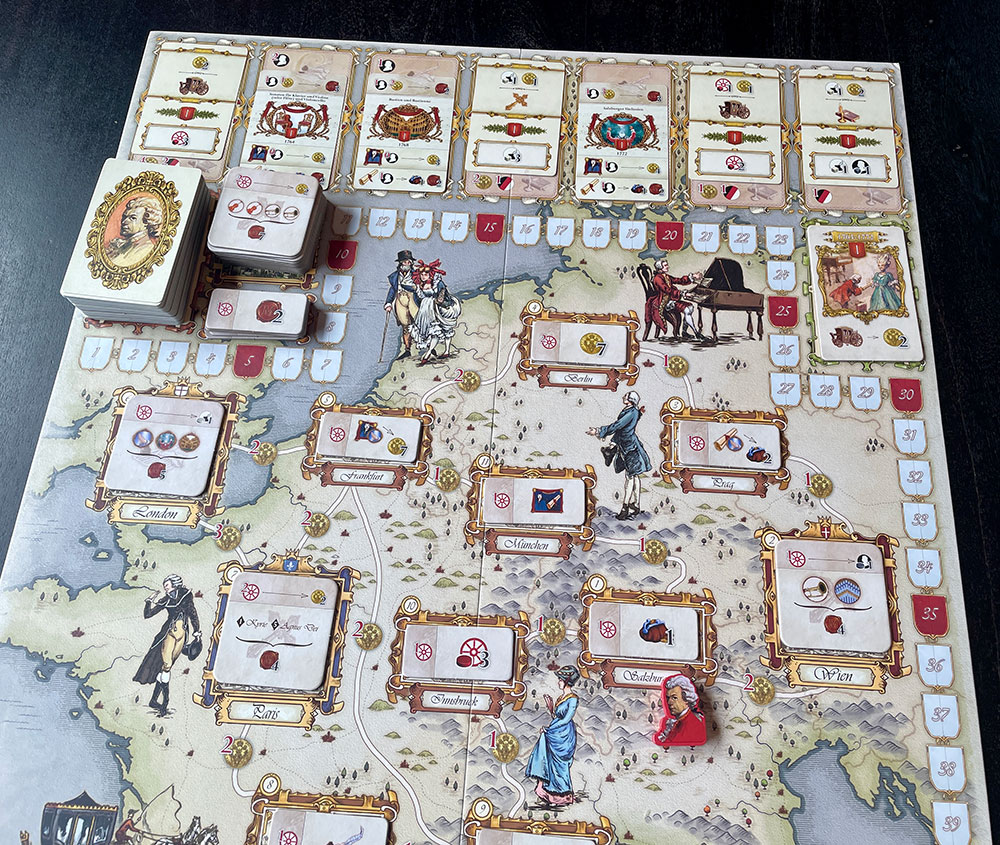
Game Experience:
I scurried through the overview to discuss this design. First off, what an intriguing thematic choice. While Lacrimosa’ sea of beige and staunch European illustration places it firmly in the Euro strategy camp, it blends several mechanisms and couples these with the most curious narrative. Players are patrons vying to be the best at remembering their time with Mozart, spending sweet, sweet coin on the composition, and interacting with performances from the past (or present?). It doesn’t all come together thematically, but each action is rooted in specificity to service the dizzying sense of place. It’s as if two timelines have been smashed together.
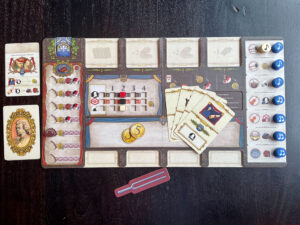
Thankfully gameplay is fun, enough to forget the theme’s lack of cohesion as time goes on. Turns move quickly and players only have four cards to choose from at any given moment. Iconography is straightforward, and it takes very little to complete an action. This is not a game of complex combos, though it is a puzzle of utilizing the actions available to you in an efficient way. As such, there’s room for AP, but the game tries its best to minimize this.
There’s plenty of variability as well, with the market deck being seeded before play, specific end-of-round bonuses chosen at random, as well as four different composers with their own specific bonuses to explore. This is enhanced by the City and Royal Court tiles that see play during the game, as well as their distance when taking a travel action. Lacrimosa also has above-average player scaling. The Requiem will have certain spaces covered by a randomly chosen Constanze card, which tightens the area control battle, and the market deck is minimized by the number of players. The only area that isn’t adjusted is the map, but since players are sharing the Mozart token, it isn’t as imperative to scale this down.

The gameplay is also tight. With only five rounds and four cards each round, there’s a lot to pull off in little time. Focusing on specific areas may help with efficiency, but unless you can truly build a deck that compliments this by buying upgrade cards, which drains your resources and cannot be played until the next round, then you’re stuck with the starting deck most of the time. As such, Lacrimosa leans into hand management more than deck builder as there’s not enough time to fully explore that facet of the game. But it can’t be ignored completely either. Memory cards provide powerful additional actions as eras progress.
This leads me to the concern. Lacrimosa does a lot of things well, but it lacks a lot of depth over time. You’ll find that the end-of-round bonus tiles provide very little incentive, the path forward is many times dictated by what you can safely procure from the card market, and the Royal Court tiles take too much effort to reap the benefits. Over a short amount of time, we’ve developed a certain meta around specific areas of the game, knowing that they are better opportunities for scoring. New players will suffer against those who’ve played this before.
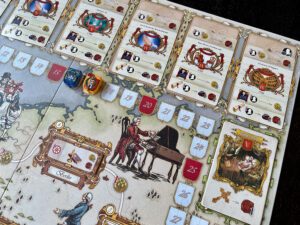
That’s rough because there’s a lot to like here. The Story Tracks with their limited resources is a nice restrictive element. The limitation of how many instruments each player has access to, as well as which instruments are needed in the composition, makes for a fun area control battle at all player counts. The inclusion of a single neutral token attached to one horn provides a wrinkle for gaining control. There’s even a rule that asks players to flip over leftover city and royal tiles to their more lucrative gilded side to try and entice players to use the travel action more often. I also tackled the solo mode, and I applaud it for its challenge and ease of use.
Final Thoughts:
What a journey. Lacrimosa suggests thematic saturation but leaves most of it in the imagination of the player. Sure, we’re given a five-movement unfinished composition, a map featuring prominent cities in Europe, musical notes on tokens and in-era artwork. Even the end-of-round bonus tiles showcase era-specific date ranges. And yet there’s not a lot here that truly connects to a narrative experience outside of the passage of time. No historical tidbits, no juicy gossip, no career highlights. But Devir knows how to produce a game, and they continue to choose great designs that are a lot of fun to puzzle through. Even with the thematic disconnect, I’d still place this in the upper tier of Devir’s collection, right below The Red Cathedral. And if you’ve taken time for yourself to heal from the news of Mozart’s sudden passing, there’s no better time than the present to see if this new addition to the mid-weight strategy game is as impressive to you as its inspiration is to so many others.
Final Score: 3.5 stars – A medley of mechanisms and quality production are almost enough to supplant the fact that Lacrimosa is missing a few notes.
 Hits:
Hits:
• Unique area control design
• Hand management puzzle
• Excellent production quality
• Nice variability and scaling
Misses:
• Card illustration (and deckbuilding) bland
• Period bonus tiles underwhelm
• Royal Court investments
• Thematic confusion







